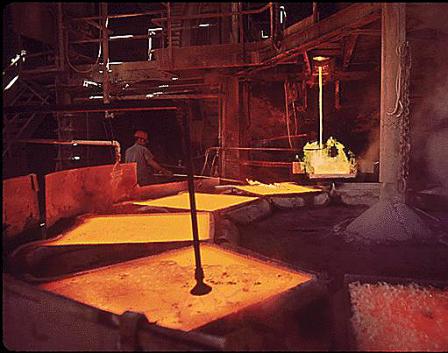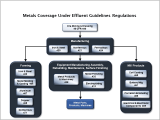Nonferrous Metals Manufacturing Effluent Guidelines
 EPA promulgated the Nonferrous Metals Manufacturing (NFMM) Effluent Guidelines and Standards (40 CFR Part 421) initially in 1974-1976, and added subcategories and revised the regulations in 1980-1990 pursuant to Clean Water Act amendments and litigation. The regulations cover wastewater discharges from a wide range of metal manufacturing facilities. The NFMM Effluent Guidelines and Standards are incorporated into NPDES permits for direct dischargers
EPA promulgated the Nonferrous Metals Manufacturing (NFMM) Effluent Guidelines and Standards (40 CFR Part 421) initially in 1974-1976, and added subcategories and revised the regulations in 1980-1990 pursuant to Clean Water Act amendments and litigation. The regulations cover wastewater discharges from a wide range of metal manufacturing facilities. The NFMM Effluent Guidelines and Standards are incorporated into NPDES permits for direct dischargers![]() direct dischargerA point source that discharges pollutants to waters of the United States, such as streams, lakes, or oceans., and permits or other control mechanisms for indirect dischargers
direct dischargerA point source that discharges pollutants to waters of the United States, such as streams, lakes, or oceans., and permits or other control mechanisms for indirect dischargers![]() indirect dischargerA facility that discharges pollutants to a publicly owned treatment works (municipal sewage treatment plant). (see Pretreatment Program).
indirect dischargerA facility that discharges pollutants to a publicly owned treatment works (municipal sewage treatment plant). (see Pretreatment Program).
- What is Nonferrous Metals Manufacturing?
- Facilities Covered
- Rulemaking History
- Additional Information
What is Nonferrous Metals Manufacturing?
Primary metals manufacturers extract metals from ores and operate smelters, which heat ore mixtures to separate liquid metal and impurities. Secondary manufacturers process recycled or scrap metals. Extraction processes include chemical addition (e.g. limestone, coke, soda ash) and treatments (e.g. solvents). Some processes involve application of electrical current (e.g., aluminum, tin). The metals may be cast into various shapes (e.g., billets, ingots, bars) prior to shipment to customers, which fabricate final products.
The wastewater streams generated by the industry vary according to the metal extraction processes employed, but generally derive from smelter furnace and filtration residues, rinsing of materials, spent solutions, equipment cooling and air pollution controls (wet scrubbers).
-
331313: Alumina Refining and Primary Aluminum Production
-
331314: Secondary Smelting and Alloying of Aluminum
-
331410: Nonferrous Metal (except Aluminum) Smelting and Refining
-
331492: Secondary Smelting, Refining, and Alloying of Nonferrous Metal (except Copper and Aluminum)
Note: The NAICS group listing is provided as a guide and does not define the coverage of the NFMM regulations. For precise definitions of coverage, see the applicability sections in 40 CFR Part 421.
Note: Many post-extraction processes such as rolling, drawing, extruding and foil fabrication are covered by the Nonferrous Metals Forming and Metal Powders Category, (40 CFR Part 471), the Aluminum Forming Category (40 CFR Part 467), and the Copper Forming Category (40 CFR Part 468).
Facilities Covered
The NFMM effluent guidelines apply to facilities in 31 subcategories:
- Bauxite Refining
- Primary Aluminum Smelting
- Secondary Aluminum Smelting
- Primary Copper Smelting
- Primary Electrolytic Copper Refining
- Secondary Copper
- Primary Lead
- Primary Zinc
- Metallurgical Acid Plants
- Primary Tungsten
- Primary Columbium-Tantalum
- Secondary Silver
- Secondary Lead
- Primary Antimony
- Primary Beryllium
- Primary and Secondary Germanium and Gallium
- Secondary Indium
- Secondary Mercury
- Primary Molybdenum and Rhenium
- Secondary Molybdenum and Vanadium
- Primary Nickel and Cobalt
- Secondary Nickel
- Primary Precious Metals and Mercury
- Secondary Precious Metals
- Primary Rare Earth Metals
- Secondary Tantalum
- Secondary Tin
- Primary and Secondary Titanium
- Secondary Tungsten and Cobalt
- Secondary Uranium
- Primary Zirconium and Hafnium
Rulemaking History
1990 Amendment
- Documents, including:
- Final rule (August 3, 1990)
- Development Document - Consolidation of all BAT Phase I & II revisions (May 1989)
- Proposed rule (April 28, 1989)
1988 Amendment
- Documents, including:
- Final rule (January 21, 1988)
- Proposed rule (January 22, 1987)
1987 Amendment
- Documents, including:
- Final rule (July 7, 1987)
- Proposed rule (May 20, 1986)
1985 Amendment
- Documents, including:
- Final rule (September 20, 1985)
- Proposed rule (June 27, 1984)
1984 Amendment
- Documents, including:
- Final rule (March 8, 1984)
- Notice of data availability (November 21, 1983)
- Proposed rule (February 17, 1983)
1980 Amendment
- Final rule (July 2, 1980)
1976 Initial Rulemaking
- Documents, including:
- Interim final rule (PSES, Subparts C, F) (December 15, 1976)
- Proposed rule (NSPS, PSNS, PSES; Subparts D, E, F, G, H) (February 27, 1975)
1975 Initial Rulemaking
- Documents, including:
- Interim final rule (February 27, 1975)
- Proposed rule (April 8, 1974)
1974 Initial Rulemaking
- Documents, including:
- Final rule (April 8, 1974)
- Proposed rule (November 30, 1973)
Additional Information
For additional information regarding the NFMM Effluent Guidelines, please contact Ahmar Siddiqui (siddiqui.ahmar@epa.gov) or 202-566-1044.

